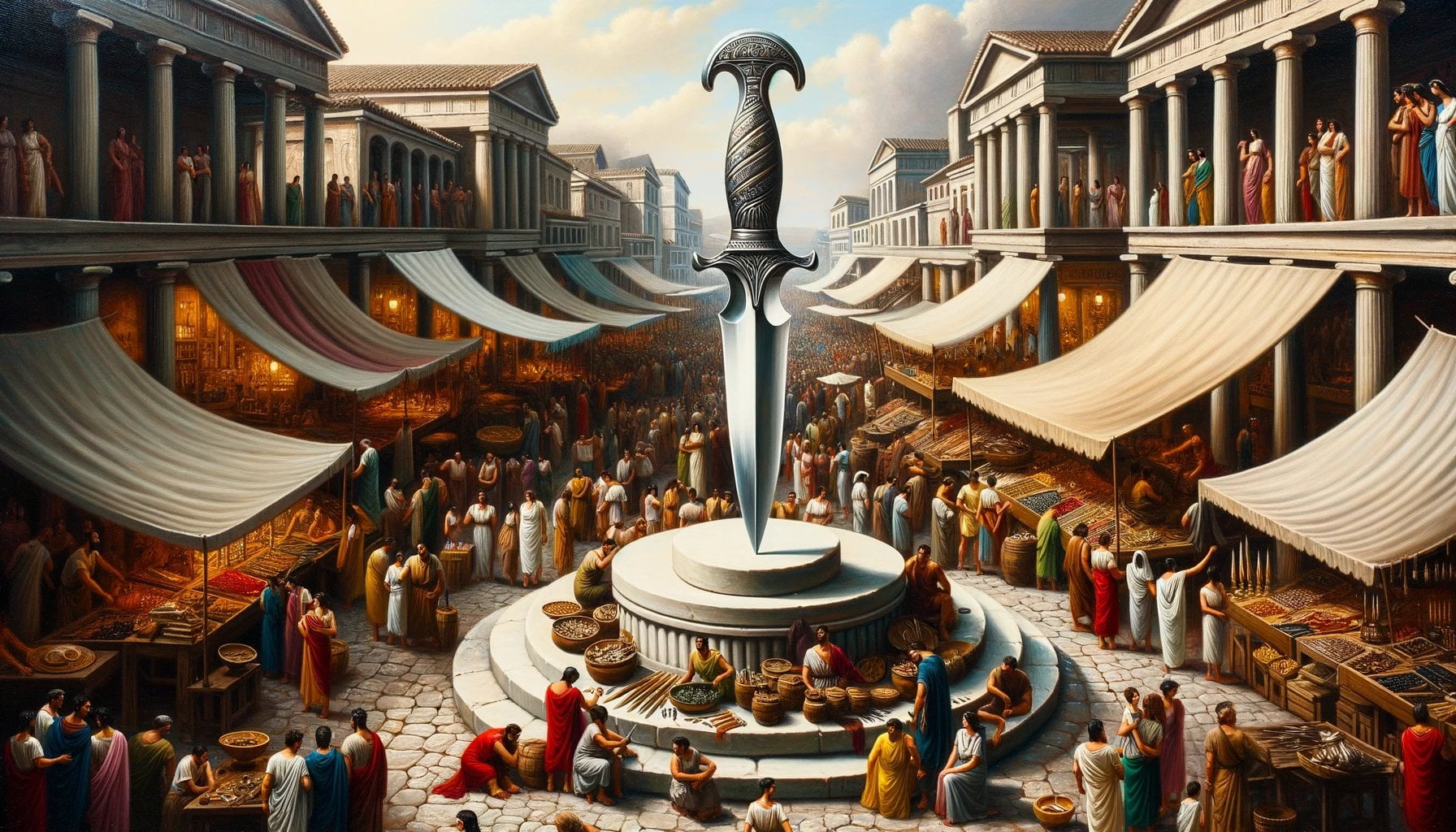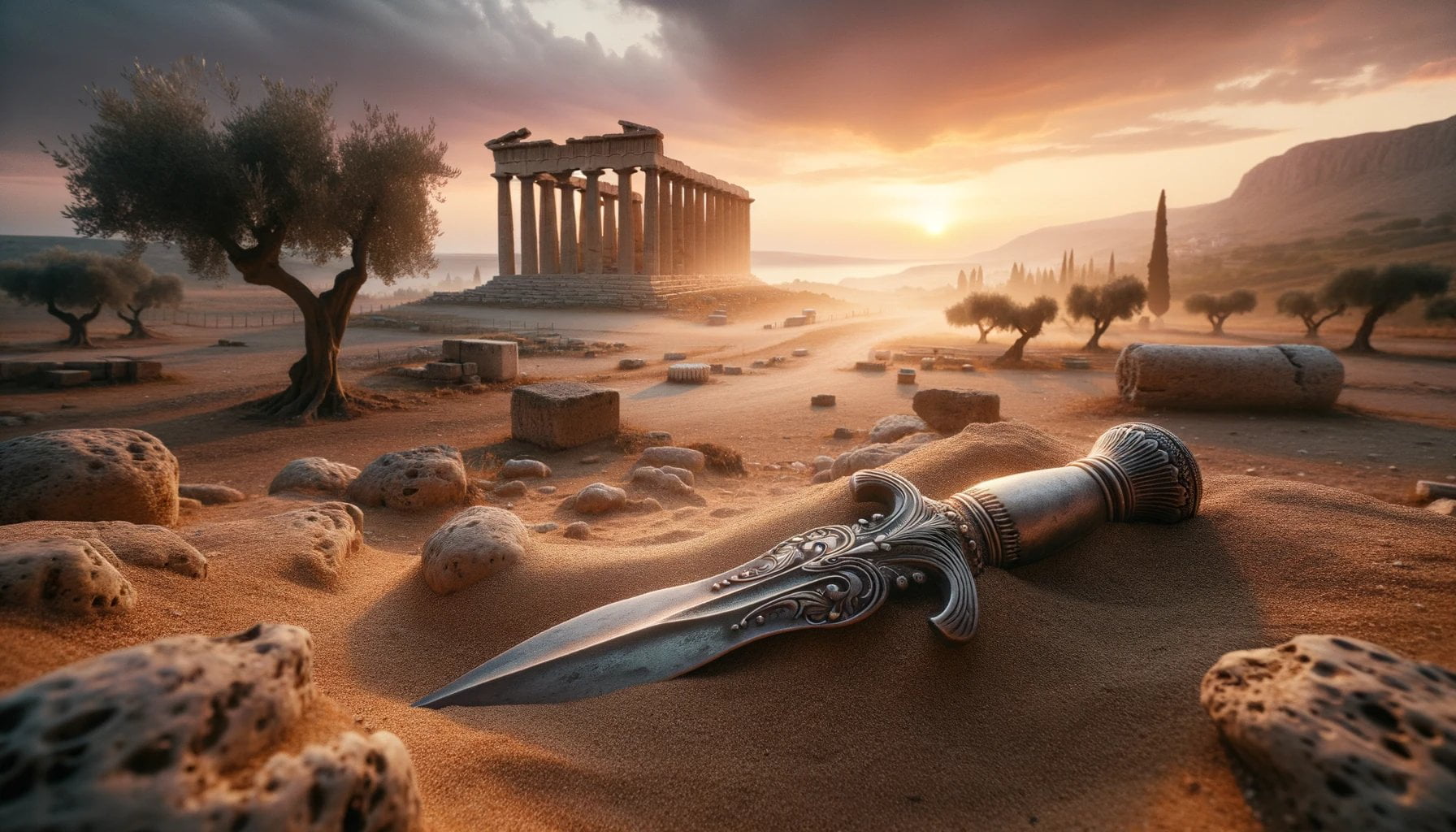Unveiling Greek Dagger: Significance, Designs, and Societal Roles. Enter the captivating world of ancient Greece, where the power and prestige of the Greek daggers reigned supreme. Known for their exceptional craftsmanship and intricately detailed designs, these weapons bear witness to a rich tapestry of history. As we embark on this journey, we will delve into the realm of ancient daggers, exploring their significance, admiring their designs, and unraveling the pivotal societal roles they played in Greek antiquity.

What were Greek daggers called?
In ancient Greece, there were different types of daggers, each with its own unique name and purpose. Let’s delve into the fascinating world of Greek daggers and uncover their significance, designs, and the roles they played in society.
Xiphos: The Versatile One-Handed Sword
One of the most well-known Greek daggers is the xiphos. This double-edged, one-handed straight shortsword was widely used by ancient Greek soldiers. It served as a secondary weapon on the battlefield, complementing other primary weapons like the dory or javelin. The xiphos was designed to be lightweight yet sturdy, allowing soldiers to move swiftly and perform quick, versatile movements in combat. Its balanced design made it suitable for both slashing and thrusting attacks.
Kopis: The Curved Cutting Tool
Another intriguing Greek dagger is the kopis. This heavy knife featured a forward-curving blade and served multiple purposes. While it was commonly used as a tool for cutting meat, it also held significance in ritual slaughter and animal sacrifice. Additionally, the kopis could function as a single-edged cutting or “cut and thrust” sword, thanks to its unique blade shape. With its curved design, the kopis enabled effective slashing attacks, making it a formidable weapon in both combat and practical tasks.
Makhaira: The Mighty Bladed Weapon
The makhaira was another notable type of Greek dagger. It resembled a large knife or sword with a single cutting edge. This versatile bladed weapon was employed by both soldiers and civilians alike. With its sharp edge, the makhaira delivered powerful cuts, making it formidable in battles and other confrontations. Its design and usage significantly influenced warfare and everyday life in ancient Greece.
In ancient Greek society, these daggers found their place in the hands of various individuals. Soldiers relied on the xiphos as their trusty secondary weapon, while the kopis served as a practical tool for cutting meat and taking part in ritual practices. The makhaira, with its impressive cutting capability, was wielded by both warriors and civilians.
The Dynamic Techniques of Greek Dagger Fighting
How were these Greek daggers employed in combat? They were used for slashing, thrusting, and cutting. The xiphos, as a one-handed sword, allowed for swift movements and versatility on the battlefield. Picture it as a nimble dancer, effortlessly maneuvering through the chaos of war. On the other hand, the kopis, with its curved blade, excelled in inflicting devastating slashes. Its unique design enabled fighters to strike with force and accuracy. Finally, the makhaira, with its single cutting edge, was a force to be reckoned with. Its mighty cuts could swiftly disable an opponent.
These daggers played a significant role in shaping warfare and daily life in ancient Greece. They not only provided soldiers with reliable backup weapons, but they also served practical purposes in everyday tasks. The designs and functionalities of these daggers exemplified the ingenuity and craftsmanship of Greek artisans.
To summarize, Greek daggers were an integral part of ancient Greek culture. The xiphos, kopis, and makhaira each possessed their own unique characteristics and purposes. From providing a soldier with a secondary weapon to serving as a versatile tool for everyday tasks, these daggers left an indelible mark on Greek history.
Types of Greek Daggers
| Dagger | Description |
|---|---|
| Xiphos | A double-edged, one-handed straight shortsword for Greek soldiers. |
| Kopis | A heavy knife with a forward-curving blade used for cutting and combat. |
| Makhaira | A large knife or sword with a single cutting edge, versatile in use. |
Ancient daggers were more than just weapons – they carried the stories of an era long gone. Explore the fascinating world of ancient daggers here and uncover the secrets they hold. Whether you’re a history enthusiast or simply curious, this journey into the past will surely captivate you.
Discussion of the different Types and Designs of Greek Daggers
The use of daggers in ancient Greece was widespread, fulfilling various roles in both warfare and everyday life. These weapons were often employed as secondary weapons, accompanying primary ones like spears or swords. In this discussion, we will delve into the fascinating world of Greek daggers, exploring their different types and designs.
The Evolution of Greek Daggers
Greek daggers have a long history, dating back to the early Bronze Age around the 3rd millennium BC. Copper daggers were among the earliest known examples, but they were not merely ceremonial objects as previously believed. Recent research has revealed that these prehistoric daggers were actually used for slaughtering and butchering animals, showcasing their practical purposes.
Moving forward, daggers from Crete in the Early Bronze Age were discovered in both settlement sites and tombs, shedding light on their significance among the ancient Cretan civilization. In the Mycenaean period, ceremonial daggers made of bronze and adorned with silver, gold, and niello inlay were prominent. Laboratory analysis has also revealed that the black material used in the pictorial inlays may have been tar or resin, adding a touch of mystery to these ancient artifacts.
Types of Greek Daggers
Greek daggers come in various types, each with its distinct characteristics and purposes. Let’s explore some of the most notable ones:
Xiphos
One well-known type of Greek dagger is the xiphos, a secondary weapon wielded by ancient Greek soldiers on the battlefield. This dagger was renowned for its lightweight yet sturdy construction, making it suitable for both slashing and thrusting attacks. Its design allowed for swift movements and versatility, providing soldiers with a reliable backup weapon when engaged in combat.
Kopis
Another intriguing dagger is the kopis, characterized by its heavy knife-like design with a forward-curving blade. While it served practical purposes such as cutting meat and ritual slaughter, the kopis also excelled in combat due to its formidable slashing attacks. Its curved blade enabled devastating slashes, making it a fearsome weapon in the hands of skilled warriors.
Makhaira
Lastly, we have the makhaira, a large knife or sword with a single cutting edge. The makhaira was not limited to use by soldiers; it was also employed by civilians. This dagger delivered powerful cuts, capable of swiftly disabling opponents. Its significance extended beyond battles, as it played a vital role in various aspects of daily life in ancient Greece.
Designs and Significance of Greek Daggers
Greek daggers stood as testaments to the ingenuity and craftsmanship of this ancient civilization. Their designs showcased the Greeks’ deep understanding of functional and aesthetic elements, resulting in weapons that were both practical and visually pleasing.
From the simple yet effective design of the xiphos to the distinctive curve of the kopis and the mighty cutting edge of the makhaira, Greek daggers combined form and function. Their significance extended beyond warfare, as these weapons also served as everyday tools, aiding in various tasks.
In conclusion, the world of Greek daggers is a captivating one, offering a glimpse into the rich tapestry of ancient Greek civilization. Through their different types and designs, these daggers played significant roles in both warfare and daily life. Their evolution over time showcases the ingenuity and skill of the Greeks, leaving behind a legacy of remarkable artifacts that continue to intrigue historians and enthusiasts alike.
Greek Dagger Types and Designs
| Dagger Type | Design |
|---|---|
| Xiphos | Lightweight and sturdy construction suitable for slashing and thrusting attacks. |
| Kopis | Heavy knife with a forward-curving blade, excels in slashing attacks. |
| Makhaira | Large knife or sword with a single cutting edge, delivers powerful cuts in battle and everyday life. |
Now that we have explored the different types and designs of Greek daggers, it is clear how these weapons contributed to the rich tapestry of ancient Greek civilization. From their practical purposes in combat to their significance in daily tasks, Greek daggers truly embody the essence of Greek ingenuity and craftsmanship. So, the next time you come across a Greek dagger, take a moment to appreciate the multifaceted roles it played in shaping the history of ancient Greece.
Insight into the Materials Used in the Construction of Greek Daggers
The construction of Greek daggers involved a careful selection of materials that played a crucial role in their functionality, durability, and aesthetic appeal. In this article, we will delve into the fascinating world of Greek daggers, shedding light on the materials used and their significance in the construction process.
Introduction
Greek daggers were not merely weapons; they were cultural artifacts that reflected the ingenuity and craftsmanship of ancient Greek civilization. To fully understand these daggers, we must explore the materials that were chosen to fashion them.
Bronze: The Foundation of Greek Daggers
The primary material used in the construction of Greek daggers was bronze. During the early Bronze Age in Greece, which began in the 3rd millennium BCE, copper daggers were prevalent. However, as technology advanced, bronze emerged as the preferred material for daggers due to its superior strength and durability.
Bronze, an alloy composed primarily of copper and tin, offered several advantages for crafting daggers. It provided the necessary hardness for effective slashing, thrusting, and cutting in combat, making Greek daggers formidable weapons. Furthermore, bronze was highly resistant to corrosion, allowing these precious weapons to withstand the test of time.
Adornments and Inlays: Adding Artistic and Symbolic Value
In addition to the functional aspects, Greek daggers often featured intricate adornments and inlays, which amplified their artistic and symbolic value. Bronze daggers from the early Mycenaean period in mainland Greece, for example, were adorned with exquisite silver inlays, gold, and niello. These ornate embellishments showcased the Greeks’ appreciation for aesthetics and their skill in metalworking.
These decorative elements were not merely for show; they carried symbolic meanings and represented the social status and identity of the individuals who wielded them. By incorporating beautiful designs and precious materials into the construction of Greek daggers, the ancient Greeks demonstrated their cultural sophistication and refinement.
Table: Materials Used in Greek Dagger Construction
Here is a brief overview of the materials commonly used in the construction of Greek daggers:
| Material | Description |
|---|---|
| Bronze | Primary material, providing strength and durability |
| Copper | Predominantly used in early Bronze Age daggers |
| Tin | Component of bronze alloy, enhancing hardness |
| Silver | Used for intricate inlays and decorative embellishments |
| Gold | Featured in ornate designs, symbolizing wealth and prestige |
| Niello | Black metallic alloy used for inlay decoration |
Conclusion
Greek daggers were not merely functional weapons; they were masterpieces that reflected the rich tapestry of ancient Greek civilization. The choice of materials, such as bronze, copper, silver, gold, and niello, played a significant role in the construction process, contributing to the daggers’ strength, durability, and artistic appeal. By understanding the materials used in the creation of these daggers, we gain valuable insights into the skill, craftsmanship, and cultural significance of ancient Greek society.
So, next time you encounter a Greek dagger, take a moment to appreciate the materials that brought it to life and the stories it holds within its ancient design.
Exploration of the Ceremonial and Practical Uses of Greek Daggers in Greek Culture
In ancient Greece, daggers held immense significance and played diverse roles in both ceremonial practices and practical daily life. These ancient blades, often crafted with meticulous skill and adorned with intricate designs, showcased the ingenuity and craftsmanship of the Greeks.
Ceremonial Uses of Greek Daggers
Greek culture encompassed a myriad of ceremonies, and the ceremonial use of daggers held particular importance. These ceremonial daggers, typically made of bronze and embellished with silver, gold, and niello inlays, served as symbols of social status and identity. In many Greek ceremonies, handheld vessels were used to pour libations, and the inclusion of ceremonial daggers enhanced the solemnity and fervor of these rituals.
Practical Uses of Greek Daggers
Beyond their ceremonial significance, Greek daggers were utilized for various practical purposes in everyday life. One such use was butchering and carving animals, as daggers proved essential in tasks such as slaughtering livestock and preparing meat. The Greeks recognized the versatile nature of these weapons, employing them not only in warfare but also for everyday tasks that required precise cutting and slicing.
Diverse Designs of Greek Daggers
Greek daggers came in a variety of designs, each tailored to suit specific functions and combat techniques. One prominent example is the Cretan Dagger, associated with the history and culture of Crete. The unique shape and design of this dagger made it distinct from others, serving as a testament to the diverse range of Greek dagger craftsmanship.
Role of Greek Daggers in Warfare
Greek daggers held significant positions in ancient warfare, often serving as secondary weapons complementing primary ones like spears or swords. The swift and versatile movements enabled by daggers like the xiphos made them ideal for close combat. The kopis, with its forward-curving blade, excelled in delivering devastating slashes, proving to be a formidable weapon on the battlefield. Additionally, the makhaira, with its single cutting edge, played a vital role in battles and daily life, delivering powerful cuts that could swiftly disable opponents.
Greek Daggers as Cultural Artifacts
The sophistication and artistry present in Greek daggers distinguish them as cultural artifacts. Bronze was the primary material used in their construction, offering superior strength, durability, and resistance to corrosion. The decorative elements, such as silver, gold, or electrum inlays, further showcased the Greeks’ understanding of both functionality and aesthetics. These adornments represented social status and added symbolic value to the daggers, making them not only weapons but also masterpieces of ancient Greek craftsmanship.
Conclusion
Exploring the ceremonial and practical uses of Greek daggers in Greek culture reveals their intricate significance and multifaceted roles. From playing a crucial part in ceremonies to serving as versatile tools in daily life and warfare, Greek daggers showcased the prowess and ingenuity of ancient Greek civilization. Their unique designs, meticulous craftsmanship, and symbolic embellishments make them invaluable cultural artifacts that continue to captivate historians, archaeologists, and enthusiasts to this day.

FAQ
Q1: What were the different types of daggers used in ancient Greece?
A1: In ancient Greece, there were several types of daggers used for different purposes. Some of these included the xiphos, kopis, and makhaira.
Q2: What was the xiphos dagger used for?
A2: The xiphos dagger was a double-edged, one-handed straight shortsword used as a secondary battlefield weapon by ancient Greek soldiers.
Q3: What was the kopis dagger used for?
A3: The kopis dagger was primarily used as a tool for cutting meat, ritual slaughter, and animal sacrifice. It could also be used as a single-edged cutting or “cut and thrust” sword.
Q4: Who used the makhaira dagger in ancient Greece?
A4: The makhaira dagger was a type of bladed weapon used by both soldiers and civilians in ancient Greek society.
Q5: What were the fighting techniques associated with Greek daggers?
A5: Greek daggers were used for slashing, thrusting, and cutting. The xiphos allowed for quick and versatile movements in combat, while the kopis was effective for slashing attacks. The makhaira could deliver powerful cuts with its single cutting edge.
- China II Review: Delicious Food & Speedy Service - April 17, 2025
- Understand Virginia’s Flag: History & Debate - April 17, 2025
- Explore Long Island’s Map: Unique Regions & Insights - April 17, 2025
















